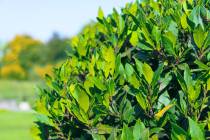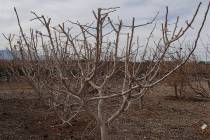Debunking the myths of pine needle mulch
Q: We have 14-year-old pine trees with large water berms under them for collecting water. The inside of these berms are full of pine needles that I hoped would help hold moisture but they do not deteriorate. Should they be left under the trees or be removed? Should I use some other mulch to help with moisture?
A: Anything that will let the soil “breathe” but shades the surface (reduces sunlight) and slows wind movement across the surface will slow the release of moisture from the soil and help conserve water.
Pine needles help as a surface mulch but decompose slowly when composting if they aren’t mixed with other green waste. Not only that, when they do decompose they don’t contribute much in the way of nutrients when they decompose.
Some anecdotes floating around suggest that pine needles are very acidic when they decompose or that they don’t decompose. These are false.
Most everything that decomposes releases some acidity. Pine needles will decompose in compost piles, albeit slower, if mixed with other things that are breaking down. I will post some references on pine-needle litter and decomposition on my blog.
Q: What’s wrong with my peach tree? Half of the branches are dying.
A: Peach is a pretty good magnet for boring insects or borers. This is the main reason they are fairly short-lived in our climate. I am pretty confident this is the problem.
Borer damage commonly occurs on the upper surfaces of limbs that are growing more or less horizontally and on west or south facing areas of the trunk. These are the areas that can easily sunburn. Sunburned areas of trees attract boring insects.
There is not much you can do now to rid yourself of boring insects and feel comfortable eating the fruit next year. But you could wait for this winter and do some corrective tree surgery. If the tree is in pretty bad shape, you should consider replacing it.
I will refer to some of my other postings for controlling this insect in my blog.
Q: I have four pampas grass that I always cut back in the fall. However since moving here three years ago, I’ve enjoyed the white blooms during the winter and cut them back in February. They bloomed in August those years. However, because of age I now need help. My part-time gardener told me that the grasses did not need to be cut back to bloom this summer.
A: Pampas grass is native to areas that receive periodic fires. These fires help to prune this grass to the ground. If you prune them to the ground every spring, the foliage will look great in the summer but it will delay the bloom until later. If you don’t prune pampas grass it will flower earlier but the foliage can begin to look a bit unsightly.
Prune pampas grass annually or every two to four years to remove unsightly foliage. It’ll grow back. Pruning is best done in late winter, before the new growing season. February is great.
Prune them to ground level. Be sure to wear protective clothing. (The edges of the leaves have tiny teeth that make the plant challenging to work with.) After pruning, fertilize around the plant’s base once in the growing season with the tree and shrub fertilizer and water it in.
Pampas grass plumes are great for use in floral arrangements, fresh or dried. Harvest the flowers as soon as they emerge. Spray the plumes with hairspray to keep them from falling apart.
Q: We have a fertilizer tank attached to our watering system. I’ve had it checked and it is working well. However, this summer most of the plants in my perennial flower garden, yellow bells, and bougainvillea are green but have few blooms. Lantanas and purple rubella are blooming well.
A: Fertilizer tanks attached to an irrigation system can be a big plus for overall landscape quality. However, there are some things you should realize about using fertilizer tanks and fertilizer injectors.
Plants receiving the most water also receive the most fertilizer. When using fertilizer injectors it is best to inject fertilizer several minutes after the cycle begins and stop fertilizing several minutes before the cycle turns off.
This gives better fertilizer distribution to all of the plants and cleans the irrigation lines out of any extra fertilizer. Water containing fertilizer in irrigation lines will contribute to plugging because of increased algae and bacterial growth.
If your system can’t flush the lines with clean water, flush the lines yourself once a month with fresh water by turning off the injector for a few irrigations.
Consider using the fertilizer tank periodically, perhaps once or twice a month, instead of continuously.
Typically, plants at the beginning of an irrigation line receive more than those at the end of an irrigation line. Eliminate some of this problem by installing an air-release valve or air vent somewhere along the irrigation line.
Air release valves allow trapped air to exit the irrigation line and speeds the delivery and accuracy of water and fertilizer to all of the plants. Otherwise air can be pushed ahead of the water and slow the delivery of water and fertilizer along the length of the irrigation line.
The type of fertilizer you use may affect plants, too. Use a general-purpose fertilizer with a ratio of 3-1-2 or 4-1-2 (nitrogen-phosphorus-potassium). Apply very low levels of phosphorus if we are feeding plants continually.
Phosphorus can build up in the soil and become a problem if too much is applied. If particular plants require higher amounts of phosphorus, they can be sprayed with a high-phosphorus fertilizer on their foliage or the fertilizer can be applied at their base and watered in.
Q: We had a major irrigation problem and where I had narcissus bulbs planted and had to dig them up. They come up faithfully and bloom so lovely every single year. I had these bulbs multiplying for nearly 45 years. Do I need to get these back into the ground right away or can I store them somewhere?
A: On narcissus, you are in luck. Narcissus, tulips, crocus, hyacinth, and ranunculus should be planted in late summer or fall. All will do well here with no additional chilling required. They’re bets planted from Late September through early November.
If you can keep them in the fridge (cold), perhaps in slightly moist sand or moist paper towels, they should keep that long so you can plant them in another six to eight weeks.
Prepare the soil where they are to be planted by double digging and incorporate compost and bone meal. Double digging is just as the name suggests. The garden spot is dug twice, all the while incorporating compost.
Plant them about 7 inches deep and no closer than 6 inches apart. Make sure they’re oriented correctly; the round ball part should be down with the neck pointing up.
Eastern exposures would be best. Bright northern exposures next and least desirable are hot south or west locations. Mulch them, too.
Bob Morris is a horticulture expert living in Las Vegas and professor emeritus for the University of Nevada. Visit his blog at xtremehorticulture.blogspot.com. Send questions to Extremehort@aol.com.























